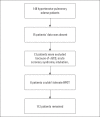Comparison of high-flow oxygen treatment and standard oxygen treatment in patients with hypertensive pulmonary edema
- PMID: 33001049
- PMCID: PMC7585958
- DOI: 10.14744/AnatolJCardiol.2020.50680
Comparison of high-flow oxygen treatment and standard oxygen treatment in patients with hypertensive pulmonary edema
Abstract
Objective: The aim compares the blood gases, vital signs, mechanical ventilation requirement, and length of hospitalization in patients with hypertensive pulmonary edema treated with standard oxygen therapy (SOT) and high-flow oxygen therapy (HFOT).
Methods: This prospective observational study was conducted in patients with tachypneic, hypoxemic, hypertensive pulmonary edema. The patients' 0th, 1st, and 2nd hour blood gas results; 0th, 1st, and 2nd hour vital signs; requirement of endotracheal intubation, length of hospitalization, and the prognosis were recorded on the study form.
Results: A total of 112 patients were included in this study, of whom 50 underwent SOT and 62 received HFOT. The initial blood gas analysis revealed significantly lower levels of pH, PaO2, and SpO2 and significantly higher levels of PaCO2 in the HFOT group. Patients in the HFOT group had significantly higher respiratory rate and pulse rate and significantly lower SpO2 values. The recovery of vital signs was significantly better in the HFOT group (p<0.05). Similarly, follow-up results of arterial blood gas analysis were better in the HFOT group (p<0.05). Both length of stay in the emergency department (p<0.05) and length of intensive care unit hospitalization s significantly shorter in the HFOT group (p<0.05).
Conclusion: HFOT can be much more effective in patients with hypertensive pulmonary edema than SOT as it shortens the length of stay both in the emergency service and in the intensive care unit. HFOT also provides better results in terms of blood gas analysis, heart rate, and respiratory rate in the follow-up period.
Conflict of interest statement
Figures
Similar articles
-
Efficacy and safety of nasal high-flow oxygen in COPD patients.BMC Pulm Med. 2017 Nov 17;17(1):143. doi: 10.1186/s12890-017-0486-3. BMC Pulm Med. 2017. PMID: 29149867 Free PMC article.
-
High-Flow Oxygen Therapy During Exercise Training in Patients With Chronic Obstructive Pulmonary Disease and Chronic Hypoxemia: A Multicenter Randomized Controlled Trial.Phys Ther. 2020 Aug 12;100(8):1249-1259. doi: 10.1093/ptj/pzaa076. Phys Ther. 2020. PMID: 32329780 Clinical Trial.
-
High-flow nasal cannula oxygen therapy in acute respiratory failure at Emergency Departments: A systematic review.Am J Emerg Med. 2020 Jul;38(7):1508-1514. doi: 10.1016/j.ajem.2020.04.091. Epub 2020 May 4. Am J Emerg Med. 2020. PMID: 32389397
-
Characteristics and outcome of patients set up on high-flow oxygen therapy at home.Ther Adv Respir Dis. 2019 Jan-Dec;13:1753466619879794. doi: 10.1177/1753466619879794. Ther Adv Respir Dis. 2019. PMID: 31610722 Free PMC article.
-
High-Flow Oxygen Therapy in the Perioperative Setting and Procedural Sedation: A Review of Current Evidence.J Clin Med. 2023 Oct 23;12(20):6685. doi: 10.3390/jcm12206685. J Clin Med. 2023. PMID: 37892823 Free PMC article. Review.
Cited by
-
High-flow vs conventional oxygen therapies for acute cardiogenic pulmonary edema following hip fractures and surgery in elderly patients.Front Oncol. 2025 Apr 30;15:1520687. doi: 10.3389/fonc.2025.1520687. eCollection 2025. Front Oncol. 2025. PMID: 40371230 Free PMC article.
-
Physiological Effects of High-Flow Nasal Cannula Therapy and Its Use in Acute Cardiogenic Pulmonary Edema.Cureus. 2021 Feb 16;13(2):e13372. doi: 10.7759/cureus.13372. Cureus. 2021. PMID: 33754097 Free PMC article. Review.
-
Efficacy of high-flow nasal cannula in patients with acute heart failure: a systematic review and meta-analysis.BMC Pulm Med. 2023 Nov 28;23(1):476. doi: 10.1186/s12890-023-02782-0. BMC Pulm Med. 2023. PMID: 38017474 Free PMC article.
References
-
- Campbell DJ. Heart failure:how can we prevent the epidemic? Med J Aust. 2003;179:422–5. - PubMed
-
- Değertekin M, Erol C, Ergene O, Tokgözoğlu L, Aksoy M, Erol MK, et al. Heart failure prevalence and predictors in Turkey:HAPPY study. Turk Kardiyol Dern Ars. 2012;40:298–308. - PubMed
-
- Funk M, Krumholz HM. Epidemiologic and economic impact of advanced heart failure. J Cardiovasc Nurs. 1996;10:1–10. - PubMed
-
- Happ MB, Naylor MD, Roe-Prior P. Factors contributing to rehospitalization of elderly patients with heart failure. J Cardiovasc Nurs. 1997;11:75–84. - PubMed
Publication types
MeSH terms
LinkOut - more resources
Full Text Sources
Medical



